

Ion Electrospray Engines Could Take Cubesats to the Moon and Beyond. CubeSats are one of the cheapest, most efficient ways to get to space.
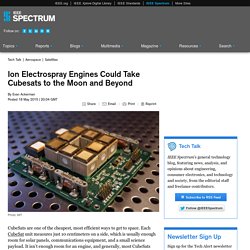
Each CubeSat unit measures just 10 centimeters on a side, which is usually enough room for solar panels, communications equipment, and a small science payload. It isn’t enough room for an engine, and generally, most CubeSats are dumped into orbit and left to fend for themselves, tumbling aimlessly until drag pulls them to earth after a few months or so. This makes them cheap for a spacecraft (usually a little over $100,000 each including launch costs), but places rather severe limits on what they’re able to accomplish. In 2013, NASA funded three different groups to develop small, highly efficient propulsion systems specifically designed to enable spacecraft like CubeSats to orient themselves, maneuver, and even change their own orbits. Computing at the speed of light: Team takes big step toward much faster computers.
University of Utah engineers have taken a step forward in creating the next generation of computers and mobile devices capable of speeds millions of times faster than current machines.
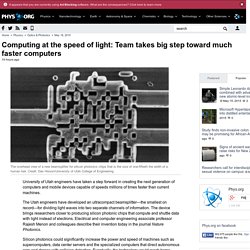
The Utah engineers have developed an ultracompact beamsplitter—the smallest on record—for dividing light waves into two separate channels of information. The device brings researchers closer to producing silicon photonic chips that compute and shuttle data with light instead of electrons. Electrical and computer engineering associate professor Rajesh Menon and colleagues describe their invention today in the journal Nature Photonics. Silicon photonics could significantly increase the power and speed of machines such as supercomputers, data center servers and the specialized computers that direct autonomous cars and drones with collision detection. Eventually, the technology could reach home computers and mobile devices and improve applications from gaming to video streaming. ARTIK. Good-Bye to Curved Lens: New Lens Is Flat.
The gently curved lentil served as the namesake for the similarly shaped lens.
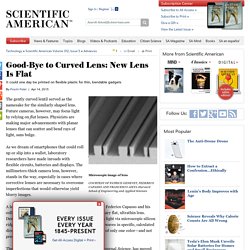
Future cameras, however, may focus light by relying on flat lenses. Physicists are making major advancements with planar lenses that can scatter and bend rays of light, sans bulge. As we dream of smartphones that could roll up or slip into a wallet, laboratory researchers have made inroads with flexible circuits, batteries and displays. The millimeters-thick camera lens, however, stands in the way, especially in cases where corrective lenses are necessary to overcome imperfections that would otherwise yield blurry images. A leap ahead came in 2012, when physicist and engineer Federico Capasso and his colleagues at Harvard University introduced a rudimentary flat, ultrathin lens.
The latest rendition, detailed online in February in the journal Science, has moved beyond proof of concept: it perfectly focuses red, green and blue light, which can be combined to yield multicolor images. NASA's Radar Found 4 Men Trapped in Rubble in Nepal By Their Heartbeats. Ten-engine electric plane prototype takes off. A team at NASA's Langley Research Center is developing a concept of a battery-powered plane that has 10 engines and can take off like a helicopter and fly efficiently like an aircraft.
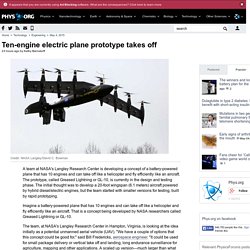
The prototype, called Greased Lightning or GL-10, is currently in the design and testing phase. The initial thought was to develop a 20-foot wingspan (6.1 meters) aircraft powered by hybrid diesel/electric engines, but the team started with smaller versions for testing, built by rapid prototyping. NailO: A thumbnail-mounted wireless trackpad. Tiny trackpad uses your thumbnail to navigate devices. Several companies are working on eye-tracking tech as a way to navigate devices.
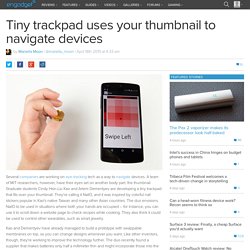
A team of MIT researchers, however, have their eyes set on another body part: the thumbnail. A Failed Lab Experiment Accidentally Invented a Replacement For Cement. Jeff Bezos Says Blue Origin's BE-3 Rocket Engine Is Ready for Flight. Blue Origin, the spaceflight company created by billionaire Amazon.com founder Jeff Bezos, says that its hydrogen-fueled BE-3 rocket engine is ready for flight testing after years of development.

"The BE-3 has now been fired for more than 30,000 seconds over the course of 450 tests," Bezos said in a statement issued Tuesday. "We test, learn, refine and then test again to push our engines. The Blue Origin team did an outstanding job exploring the corners of what the BE-3 can do, and soon we'll put it to the ultimate test of flight. " Now that acceptance testing for the BE-3 has been completed, the engine will be integrated into the company's suborbital spaceship, Blue Origin President Rob Meyerson told reporters during a Tuesday teleconference.
He said flight tests are due to begin at the company's West Texas spaceport site by the end of the year. Michigan Micro Mote - World's Smallest Computer. Michigan Micro Mote (M3), the world’s smallest computer, is taking its place among other revolutionary accomplishments in the history of computing at the Computer History Museum in Mountain View, CA.
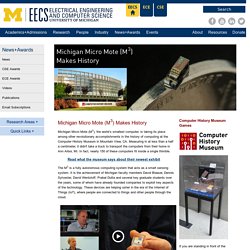
Measuring in at less than a half a centimeter, it didn't take a truck to transport the computers from their home in Ann Arbor, MI. In fact, nearly 150 of these computers fit inside a single thimble. Real-time magnet position detection using smartphone (iPhone) Self-fuelled liquid metal motor. PrintDisplay: DIY displays and touchscreens anyone can print. For years now, we've been promised miraculous new flexible touchscreen displays, but the deployment of such technology in big consumer products, like say the LG G Flex, hasn't started any revolutions just yet.

That could soon change thanks to a team of computer scientists from Germany's Saarland University who have developed a technique that could allow anyone to literally print their own custom displays, including touchscreens. View all Using a regular inkjet printer equipped with a special ink, a DIY thin-film electroluminescence (TFEL) display can simply be printed out from a digital template of the desired size and shape using a program like Microsoft Word or Powerpoint. Tokyo's underground cycle rack holds 200 bikes below the streets. By Daily Mail Reporter Published: 14:30 GMT, 8 August 2013 | Updated: 12:39 GMT, 9 August 2013 It is one of the busiest cities in the planet and so space is at a premium.
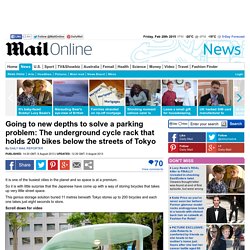
So it is with little surprise that the Japanese have come up with a way of storing bicycles that takes up very little street space. This genius storage solution buried 11 metres beneath Tokyo stores up to 200 bicycles and each one takes just eight seconds to store. Real Faces Student coding project by Rory Campbell... MIT spinoff aims to be the next solution for battery life issues. We’ve seen our fair share of companies that claim they’ll “revolutionize” smartphone battery technology, though we haven’t seen many of those breakthroughs come to the mainstream yet.

Even so, an MIT spinoff company called SolidEnergy claims to have created a new lithium-ion battery that can store far more lithium ions and still last hundreds of charging cycles. The size of the battery is reduced by a method that’s been tried many times before. SolidEnergy is replacing the usual graphite electrodes with a thin sheet of lithium-metal foil, which could potentially be dangerous. In the past, batteries using this method have either stopped working prematurely or in some instances have caused explosions. Scientist Duo Uses Laser To Create Super-Hydrophobic Material. With the help of lasers, an enterprising scientist duo at the University of Rochester has developed an entirely new material that is so hydrophobic that it causes droplets of water to bounce right off of it. Instead of coating a metal with water-repellent chemical, the team made use of laser-engraving to carve a specially-designed microscopic pattern onto its surface. According to the researchers, the substance could potentially be used to prevent rust or ice deposition on aircraft wings.
Developed by scientists, Chunlei Guo and Anatoliy Vorobyev, the water-repellent capacity of the newly-created material is far higher than the Teflon used in non-stick frying pans. Unlike Teflon surfaces that need to be tipped at a 70-degree angle to let water droplets glide off, it allows water to slide off when tilted at only 5-degrees. Recently published in the Journal of Applied Physics, the research also outlines the difference between the laser-etched metal and conventional chemical coatings. TEDxRenfrewCollingwood. Tiny, ultralight Geco 1080p action cam mounts to sunglasses. The idea of video eyeglasses and sunglasses always sounds great at first – forget strapping a boxy camera to your head and get footage straight from your glasses. What's not so great is the limited selection and acquired taste nature of the options currently available. Not everyone is into the "Red Bull-chuggin' extreme" styling of the Pivotheads or the "forgot my sunglasses so bought these at the pharmacy" look of Eyez glasses.
The tiny Geco Mark II action cam solves the problem by letting you build your own using the glasses of your choice. View all Measuring 2.4 x 0.5 x 1.2 in (60 x 12 x 30 mm) and weighing in at 20 grams, the Geco Mark II is among the smallest HD action cams on the market. Elon Musk Boosts Hyperloop With Talk of Texas Test Track. Elon Musk Boosts Hyperloop With Talk of Texas Test Track Billionaire Elon Musk says he'll build a five-mile Hyperloop test track, "most likely in Texas," that companies and students can use to try out pod designs for the tube-based rapid transit system he proposed. Musk, who founded the SpaceX rocket company and heads the Tesla electric car venture, floated the idea on Thursday at the annual Texas Transportation Forum in Austin.
In the past, Musk has said SpaceX and Tesla kept him too busy to pursue the Hyperloop concept — which he proposed as a way to go between, say, Los Angeles and San Francisco in less than an hour. [Premiere] MIT Made a Chair That Builds Itself. Fluid Assembly: Chair Test, Self-Assembly Lab, MIT + Arthur Olson + Autodesk Inc. Project Leads: Baily Zuniga, Carrie McKnelly, Athina Papadopoulou, Christophe Guberan, Chris Martin, Hannarae Annie Nam, Skylar Tibbits. Images courtesy the artists. Texas Instruments builds an alternative energy for the Internet of Things.
The Internet of Things is nothing without batteries and plugs. But it's possible to build a sensor network that uses harvested energy that comes from changes in temperature, vibrations, wind and light, as Texas Instruments (TI) will demonstrate at the Consumer Electronics Show in January. The idea of harvesting power has a long history and there are many applications of it today.
However, big solar panels or large sensors that can capture energy from vibrations, heat and light are impractical in many Internet of Things sensor applications, which are tiny in size. X MARKS THE SPOT: FALCON 9 ATTEMPTS OCEAN PLATFORM LANDING. During our next flight, SpaceX will attempt the precision landing of a Falcon 9 first stage for the first time, on a custom-built ocean platform known as the autonomous spaceport drone ship. MULTI – the world’s first rope-free elevator system. 3-D Design Software “Evolves” Hundreds of Options. Software that can “evolve” novel component designs could help designers and engineers by automating part of the creative process. Autodesk developed the computer-aided design software, called Dreamcatcher, over the past seven years. SpiderFab: Architecture for On-Orbit Construction of Kilometer-Scale Apertures. Robert HoytTethers Unlimited, Inc. Elon Musk Compares Building Artificial Intelligence To “Summoning The Demon” This past week, Tesla CEO/Living, Breathing Tony Stark/Space X Founder Elon Musk was interviewed at the MIT AeroAstro Centennial Symposium.
While the whole interview is worth watching (and is embedded above), one answer to a question from the audience takes a particularly intense turn. Asked about his thoughts on AI, Musk starts by noting that we ought to take care in closely regulating AI development, calling AI our “biggest existential threat.” Transparent optogenetic brain implants: Yet another amazing use for graphene. Transparency is the key to many technologies.
Thin conductive films, like those made from ITO (indium tin oxide) for example, can carry currents or create electric fields critical for displays or solar panels without blocking all the light. The most powerful brain implants being built today have exactly this same requirement. Namely, they need to record fast electric signals with conductive arrays while permitting light to pass out through them for high-resolution imaging — and just to take it up a notch — let light pass in to permit optogenetic control directly under the implant for the icing on the cake. Lockheed Says Makes Breakthrough On Fusion Energy Project. The Fortis exoskeleton let you lift heavy tools indefinitely – and it’s unpowered!
There are many different takes on what a human exoskeleton could look like, and a few have even been put into service to greatly augment the human body. A New Perspective (Multi-Person 3D system) - Computerphile. North Carolina's first retinal prosthesis at Duke Eye Center. FlexSense: A Transparent Self-Sensing Deformable Surface. Building lab-on-chip devices could soon be like playing with Lego. NASA Invents a Folding Solar Panel Inspired by Origami. 3D Printed Car: First Drive. New 3D Modeling Technique – Will it make 3D scanners obsolete? Real-Time Face Tracking and Projection Mapping ... Smart tattoo generates electricity from sweat, could power future wearable computers. Deep Photo: Model-Based Photograph Enhancement and Viewing. First-person Hyperlapse Videos (Technical) Microsoft’s awesome Hyperlapse tech finally makes first-person GoPro videos watchable.
These Smart Bricks Mean the Time Has Finally Arrived: Adults Have Legos of Their Own. Europe to Launch Robotic Space Plane Prototype in November. Man-made 'breathing' leaf is an oxygen factory for space travel. The Future of Desktop Computing? - Computerphile. New Display Technology Could Do Away With Reading Glasses. SpaceX Landing Restoration. Researchers may have solved graphene’s production problems, cleared way for mass production. Russian PTK NP. This Woman Invented a Way to Run 30 Lab Tests on Only One Drop of Blood. 'Smart glasses' help fix failing vision. Andy Green's 1,000mph Office Revealed. Private European Space Plane Prototype Passes 1st Drop Test (Video) Faster than Light: Warp Drive - SpaceVision 2013.
A First Drive. MIT researchers built 3D printable robots that self-assemble when heated. SpaceX unveils Dragon V2, the world’s first commercial manned reusable spaceship. Elon Musk's SpaceX Plans DragonFly Landing Tests. Stanford engineer invents safe way to transfer energy to medical chips in the body. Solar Roadways Could Power the Country and Pave the Way for Smart Road Network. Enclosed tube maglev system capable of 1,800 mph tested in China.
Reinventing the wheel. 1er vol du E-Fan d'Airbus Group Innovations Works et ACS. Lytro Unveils the ‘Illum': A Beautiful Beast of a Light-Field Camera. Meet the Teams Who Are Building the World's First Medical Tricorder. Amazing Technology Invented By MIT - Tangible Media. Scientists just created some of the most powerful muscles in existence. Gibbs Amphitrucks - Phibian High Speed Amphibian Vehicle [360p] Magical, Retractable Tire Studs Only Deploy When You Need Them. Bioengineering Dermo-Epidermal Skin Grafts with Blood and Lymphatic Capillaries. These Guys Are Creating a Brain Scanner You Can Print Out at Home. Electronic Skin. World record solar cell with 44.7% efficiency. Split is an Entire Music Player That Fits in Your Ear. Sextupteron (Demonstrating each Degree of Freedom) Two young scientists break down plastics with bacteria. Space travel, but not as we know it - meet the 'penetrator' probe.
Martin Jetpack Climbs 5000 Feet Above Sea Level. World’s first telescopic contact lens gives you Superman-like vision. The Hollow (Thermoelectric) Flashlight - Google Science Fair. A cheap nanowire ink that can boost existing solar cell efficiency by 25% Graphene Aerogel Is The World's New Lightest Material. Spray-on clothing. I Didn't Know That - Concrete Tent. M.I.T. Computer Program Reveals Invisible Motion in Video. MYO - Wearable Gesture Control from Thalmic Labs.
Fragile Italian Glass Snowboard: Every Third Thursday. Metaio announces AR processing unit for phones. The Official Ultra-Ever Dry Product Video - Superhydrophobic and oleophobic coating. The Super Supercapacitor. Researchers create versatile 3D nanostructures using DNA 'bricks' (w/ video) (Tiny) Reconfigurable Robots at MIT. Reaction Engines Ltd - Video: Alan Bond Interview.
Metamaterials manipulate light on a microchip. Nanotech device mimics dog's nose to detect explosives.
Military.